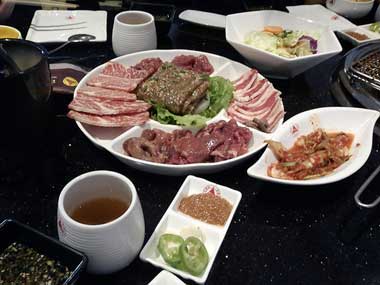South Korean Cuisine
Korean traditional, early cuisine evolved through time in its complex interaction with environmental, political and cultural trends. This contemporary amalgam is largely based upon rice, vegetables and meats, at the time it is known for the number of side dishes (banchan) that comes with steam-cooked short-grain rice. Koreans are madly obsessed with food to the point that in Seoul each popular dish has its own "town" –a street filled with restaurants all serving their versions of that particular food.
The signature dish of the national cuisine is Kimchi, which is made of vegetables with a variety of seasonings and is quintessential to every meal. There is a large range of varieties made with a main vegetable ingredient such as napa cabbage, radish, scallion or cucumber. The most common version is the one made with napa cabbage which is preserved and lightly fermented in bright red chili flakes. This chili pickled cabbage come free in almost every restaurant, but a huge sack of homemade kimchi to eat with rice can cost 5,000 Won ($4.39).
Along with Kimchi, Korean food is largely based on barbecue. Like some say, Koreans are crazy about their barbecue or gogigui. A barbecue feast comes in a myriad of plates of meat and a large assortment of side dishes and the all-important pieces of lettuce, garlic, peppers, and chili pastes to fashion little meat wraps. Interestingly enough, you must order 2 or more plates while are eating Korean barbecue; it is not viable to order just one plate. For instance, if you go to with a couple of people, you will need to order two plates of pork belly and two plates of beef, instead of one of each. The cost is around 8,000 Won ($7.00) per person.
The ideal fuel for non-stopping Korean lifestyle is a dish called tteokbokki or rice cakes in sauce. These are glutinous tubular rice cakes, generally submerged in gochujang, a red chili pepper sauce. Sindang neighborhood is the place to go to try these rice cakes, where numerous restaurants liven up the dish with cabbage, onions, noodles and fishcakes.
There is a season for every activity and a dish for every season. In this case, gamjatang –pork and potato soup- is the perfect dish to warm the cold days of winter. Gamjatang is a rich and spicy broth flavoured with garlic, onion and ground perilla seeds, plentiful chunks of potato, and a hunk of pork with the meat falling off the bone.
There are also dishes ideal for the hot, crazy, lazy, hazy days of summer, and South Korea, after all is an Asian country, which means that noodles are an intrinsic component of its cuisine. Naengmyun or cold noodles are a North Korean export, sometimes called Pyongyang naengmyun. These buckwheat noodles are served chilled, covered in diced vegetables and topped with substantial dollop of gochujang. Everything is mixed together.

